易经简介--英文
中国文化关键词的英文表达

中国文化关键词一、四大发明the Four Great inventions of Ancient China1、火药gunpowder2、印刷术printing3、造纸术paper-making4、指南针compass二、中国古代哲学家Ancient Chinese Philosophers1、孔子Confucius2、孟子Mencius3、老子Lao Tzu4、庄子Chuang Tzu5、孙子Sun Tzu6、墨子Mo Tzu三、四书The Four Books1、《大学》The Great Learning2、《中庸》The Doctrine of the Mean3、《论语》The Analects of Confucius4、《孟子》The Mencius四、书法五大书体The Five Major Styles of Chinese Calligraphy1、篆书seal script; seal character2、隶书official script; clerical script3、行书running script; semi-cursive script4、草书cursive script5、楷书regular script; standard script五、六气The Six Classical Arts1、礼rites2、乐music3、射archery4、御riding5、书writing6、数arithmetic六、汉字Chinese Characters1、汉字笔画stroke2、偏旁部首radical3、书写体系writing system4、汉藏语系Sino-Tibetan5、汉学家Sinologist; Sinologue6、中国热Sinomania7、同宗同源of the same origin8、华夏祖先the Chinese Characters9、单音节single syllable10、声调tone11、阳平、阴平、上声、去声level tone, rising tone, falling-rising tone, falling tone七、武术The Martial Arts1、中国武术kung fu2、武术门派schools of martial arts3、习武健身practice martial arts for fitness4、古代格斗术ancient form of combat5、中国武术协会Chinese Martial Art Association6、武林高手top martial artist7、气功Qigong, deep breathing exercises8、柔道judo9、空手道karate10、跆拳道tae kwon do11、拳击boxing12、摔跤wrestling13、击剑fencing14、武侠小说tales of roving knights; kungfu novels八、中国文学作品Chinese Literary Works1、《三国演义》Three Kingdoms2、《西游记》Journey to the West3、《红楼梦》Dream of the Red Mansions4、《山海经》the Classic of Mountains and Rivers5、《资治通鉴》History as a Mirror; Comprehensive History Retold as a Mirror for Rulers6、《西厢记》the Romance of West Chamber7、《水浒传》Heroes of the Marshes, Tales of the Water Margin8、《聊斋志异》Strange Tales of a Lonely Studio; Strange Tales from Make-Do Studio9、《围城》Fortress Besieged10、《阿Q正传》The True Story of Ah Q11、《春秋》The Spring and Autumn Annals12、《史记》Historical Records13、《诗经》The Book of Songs14、《易经》The Book of Changes15、《礼记》The Book of Rites16、《孝经》Book of Filial Piety17、《三字经》Three-Character Scripture; Three-Word Chant18、八股文Eight-part essay; stereotyped writing19、五言绝句five-character quatrain20、七言律诗seven-character octave九、中国建筑Chinese Architecture1、四合院quadrangle; the traditional Chinese single-story houses with rows of rooms around the four sides of a courtyard2、蒙古包(Mongolian)yurt3、碑文inscriptions on a tablet4、碑林the forest of steles5、道观Taoist temple6、殿hall7、烽火台beacon tower8、鼓楼drum tower9、华表ornamental column十、十二生肖Zodiac1、鼠Rat2、牛Ox3、虎Tiger4、兔Hare5、龙Dragon6、蛇Snake7、马Horse8、羊Sheep9、猴Monkey10、鸡Rooster11、狗Dog12、猪Pig十一、传统节日Traditional Festivals1、春节The Spring Festival拜年pay a New Year visit爆竹fire cracker除夕Eve of Chinese New Year春联Spring Couplets辞旧迎新ring out the old year and ring in the new饺子boiled dumpling锅贴pan-fried dumpling; pot-sticker庙会temple fair年画traditional Chinese New year Pictures年夜饭the Eve Feast; family reunion dinner on lunar New Year’s Eve; Banquet of Chinese New Year Eve守岁stay up late on the New Year’s Eve团圆饭family reunion dinner压岁钱New Year gift-money; money given to children as a New Year gift2、元宵节Lantern Festival元宵sweet sticky rice dumplings花灯festival lantern灯谜lantern riddle舞龙dragon dance狮子舞lion dance踩高跷stilt walking3、清明节Tomb-sweeping Day扫墓tomb-sweeping; sweep tomb sites of loved ones祭祖offer sacrifices to the ancestors踏青go for an outing in spring4、端午节Dragon Boot Festival赛龙舟dragon boot race粽子tradition Chinese rice-pudding亡灵departed soul忠臣loyal minister5、中秋节Moon Festival; Mid-Autumn Day月饼moon cake赏月appreciate the glorious full moon6、重阳节Double Ninth Day; the Aged Day7、国庆节National Day十二、京剧Beijing Opera1、变脸face-off2、生male(the positive male role)3、旦female(the positive female role)4、净a supporting male role with a striking character5、丑a down or a negative role6、花脸painted role7、独角戏monodrama; one-man show8、京剧票友amateur performer of Beijing Opera; Peking Opera fan9、脸谱mask十三、《论语》The Analects of Confucius1、己所不欲,勿施于人Do not do to others what you would not want them do to you.2、言必行,行必果Keep what you see and carry out what you do.3、有朋自远方来,不亦说乎?Isn’t it a delight to have friends coming from afar?4、知者乐山,仁者乐水The wise find pleasure in waters; the virtuous find pleasure inmountains.5、君子敏于言而甚于行The gentleman are speedy as a worker and cautious as aspeaker.6、知之为知之,不知为不知,是知也。
英文易经
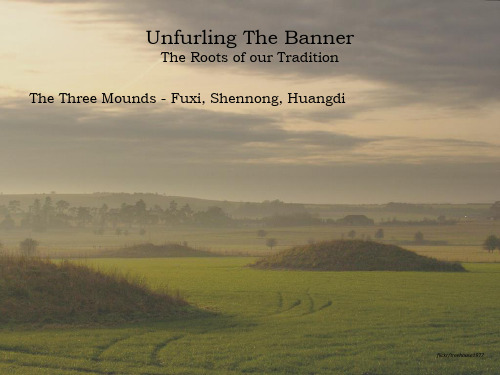
Nature. 2005 Jun 2;435(7042):673-6, there is a paper which shows clearly that ‘Oxytocin increases trust in humans’. Indeed this is the title of the study. Kosfeld M, Heinrichs M, Zak PJ, Fischbacher U, Fehr E.
元亨利贞
The Sky spring summer autumn winter
Richard Bertschinger © 2010
The True People of Old
I HAVE HEARD IT SAID THAT in those times there were people of real substance, true men of old. They lifted and raised up the skies and earth, and grasped Yin and Yang in their hands. Their out-breath and in-breath were pure energy, as alone they stood there, guarding the mind; their muscles and flesh as one. Thus their longevity was able to wear out the skies and earth, unending, and they represented the arts of health.
What is the Point?
Places of low resistance and high conductivity…., within the EMS, in the region of micro-voltage. And the charge at these points can change and be affected extremely rapidly. Notably by „external‟ factors such as …‟emotion, perspiration, movement, and respiration‟…… „which can dramatically affect the reliability of electrodermal measurements.‟ I would add to this, that if the practitioner is palpating with her or her finger-tip, then their own emotion, perspiration, amount of movement and respiration will also affect the charge.
易学基础知识

易学基础知识1. 什么是易经易经,单从名字来看,变动不居为易,圣哲彝训为经。
易经的英文名,既是Book Of Change。
依据传统的说法,易字有三层含义,即变易、不易、简易。
世间一切现象都在变化中,是为变易;变动中存在永恒的真理,是为不易;而掌握规律,以简御繁,是为简易。
若从文字结构的角度来看,易字上日下月,象征了阴阳的交替变化。
易经,就是这样的一本书。
2.周易跟易经的区别老实说,这两个概念在平常经常会被混用,不过我们还是稍微做一些区别吧。
古人云,古有三易,曰连山,曰归藏,曰周易。
古人又云,易更三圣。
一般来说,我们把孔子之前的,不包括易传的易,叫做周易,而把孔子之后的,加上了易传的易,叫做易经,是比较准确的。
毕竟按照从唐代开始的书籍四分法,易经是归于经部的嘛。
(经为儒家经典)。
3.易经的体例每一卦都有三部分组成,卦画、卦辞、爻辞。
首先,卦画。
每一卦都有自己独特的卦画,这些图案被易学家看做比卦辞、爻辞更有象征意义和表现力的部分,是每一卦的核心。
这就好比一幅画和一段文字给人的感觉,就算都是描述同一种东西,画也会常常给人更多的遐想和发挥。
每一卦由六爻组成,下面三爻组成下卦,又称内卦,上三爻组成上卦,称为外卦。
其次,卦辞。
每一卦也有自己独特的卦辞,就是卦画下面的那句话。
如果把卦比作一种药,那么卦辞就是其独有的“说明书” 。
后世学者没有三圣作易演易的大德,靠的就是卦辞爻辞来理解易经这部天书。
最后,爻辞。
每一卦都由六个爻组成,自下而上分别称为:初爻、二爻、三爻、四爻、五爻、上爻;同时由于偶数属阴,奇数属阳,易经在称呼每一爻的时候以“九”表示阳爻,“六”表示阴爻。
这样,如果初爻为阳爻,那么就是“初九” ,为阴爻就是“初六” ;同理,五爻为阳爻,称“九五” (所谓九五之尊),为阴爻,称为“六五” 。
紧跟在“初六” 、“上九”这些东西后面的那句话,就是爻辞。
每一爻都有自己的爻辞,可以说是这种药的成分指南,正是每个爻本身和相互作用,组成了一卦的丰富内容。
Introduction-and-I-Ching易经简介英文课件
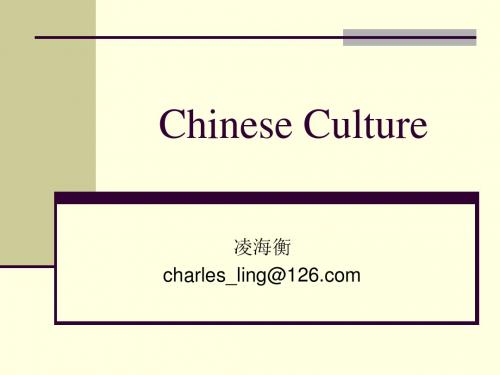
(yin --). The combinations are determined by the numerical manipulation of divining sticks, originally yarrow stalks, or milfoil蓍草.
Duke Zhou’s Philosophy of Life
At this stage, Yijing emerged as a philosophy
of life. It was no longer just a book for divination. Each situation, symbolically represented by either the hexagram as a whole or a single line in the hexagram, signifies a moral situation in life. The Judgment frequently depicts possible options in any given situation along with their possible outcomes.
The disclosure of philosophical insights
embodied in the texts of the Zhou-Yi transformed it from a text of divination into a text of philosophical wisdom.
natural elements: heaven (乾), earth (坤), water (坎), fire (离), wind (巽), thunder (震), mountain (艮), and lake (兑).
中国文化专业名词英文翻译

1版画engraving彩塑painted sculpture瓷器porcelain; china刺绣embroidery宫灯/花灯palace/festival lantern剪纸papercutting景德镇瓷器Jingdezhen porcelain木/石/竹刻wood/stone/bamboo carving唐三彩tri-colored glazed pottery of the Tang Dynasty 中国水墨画Chinese ink and wash painting陶器pottery微雕miniature engraving象牙雕刻ivory carving京剧脸谱facial make-up in Peking Opera木刻版画wood engraving木偶戏puppet show独角戏monodrama; one-man show皮影戏shadow play; leather-silhouette show京剧Peking Opera秦腔Shaanxi Opera单口相声monologue comic talk双口相声witty dialogue口技vocal imitation说书monologue story-telling杂技acrobatic performance叠罗汉making a human pyramid特技stunt哑剧dumb show; mime马戏circus performance2春节the Spring Festival元宵sweet dumplings made of glutinous rice flour 秧歌yangko年底大扫除the year-end household cleaning灯谜lantern riddle登高hill climbing拜年paying a New Year call鞭炮firecracker年画(traditional) New Year picture舞龙dragon dance春联Spring Festival couplets元宵节the Lantern Festival植树节Tree-Planting Day除夕New Year's Eve端午节the Dragon Boat Festival龙灯舞dragon lantern dance庙会temple fair年夜饭family reunion dinner on New Year's Eve清明节Tomb-Sweeping Day扫墓pay respects to a dead person at his tomb赏月admire the moon压岁钱money given to children as a lunar New Year gift;gift money辞旧迎新ring out the old year and ring in the new year中秋节Mid-Autumn Day重阳节the Double Ninth Festival十二生肖Chinese Zodiac七夕节Double Seventh Day粽子traditional Chinese rice-pudding; zong zi中餐烹饪Chinese cuisine粤菜Cantonese cuisine淮扬菜Huaiyang cuisine鲁菜Shandong cuisine川菜Sichuan cuisine3佛教Buddhism佛寺Buddhist temple道教Taoism道观Taoist temple道士Taoist priest儒教Confucianism儒家文化Confucian culture墨家Mohism法家Legalism孔庙Confucian Temple孔子Confucius《春秋》The Spring and Autumn Annals《史记》Historical Records《诗经》The Book of Songs《书经》The Book of History《易经》The Book of Changes《礼记》The Book of Rites四书The Four Books《大学》The Great Learning《中庸》The Doctrine of the Mean《论语》The Analects of Confucius《孟子》The Mencius《山海经》The Classic of Mountains and Rivers《本草纲目》Compendium of Materia Medica《资治通鉴》History as a Mirror《西厢记》The Romance of West Chamber《西行漫记》Red Star Over China《三国演义》The Romance of the Three Kingdoms《水浒传》Water Margin《聊斋志异》Strange Tales of a Lonely Studio《红楼梦》 A Dream of Red Mansions; The Story of the Stone《西游记》Pilgrimage to the West; A Journey to the West武侠小说martial arts novel言情小说romantic fiction八股文eight-part essay; stereotyped writing 五言绝句five-character quatrain七言律诗seven-character octave4民间艺术folk art高雅艺术refined art戏剧艺术theatrical art电影艺术film art爱国主义精神patriotism文化产业cultural industry文化事业cultural undertaking文化交流cultural exchange文化冲突cultural shock; cultural conflict乡村文化rural culture民族文化national culture表演艺术performing art文化底蕴cultural deposit华夏祖先the Chinese ancestor同宗同源be of the same origin中国文学Chinese literature中国武术Chinese martial arts; Kung Fu中国书法Chinese calligraphy火药gunpowder印刷术printing; art of printing造纸术papermaking technology指南针compass中国结Chinese knot青铜器bronze ware武术门派style/school of martial arts习武健身practice martial arts for fitness古代格斗术ancient form of combat武林高手top martial artist 气功qigong5无与伦比的文学创作unmatched literary creation汉语的四声调the four tones of Chinese工艺workmanship; craftsmanship手工艺品handicraft泥人clay figurine苏绣Suzhou embroidery寓言fable神话mythology传说legend公历the Gregorian calendar阴历the Lunar calendar天干Heavenly Stems篆刻seal cutting闰年leap year二十四节气24 solar terms传统节日traditional holiday才子佳人gifted scholar and beautiful lady中华文明Chinese civilization中外学者Chinese and overseas scholar寺庙temple汉学家sinologist考古学家archaeologist人类学家anthropologist历史学家historian地理学家geographer宿命论determinism守岁stay up late on New Year's Eve桂花sweet osmanthus中药traditional Chinese medicine (TCM)文明摇篮cradle of civilization明清两代the Ming and Qing Dynasties6江南South of the Yangtze River水乡景色riverside scenery上海大剧院Shanghai Grand Theater样板戏model opera《霸王别姬》Farewell to My Concubine佛经Buddhist scripture都江堰Dujiang Weir《孙子兵法》The Art of War《三字经》Three-Character Scripture旗袍cheongsam; chi-pao中山装Chinese tunic suit唐装Traditional Chinese garment; Tang suit风水geomancy胡同alley; hutong《神农本草经》Shen Nong's Herbal Classic针灸acupuncture推拿medical massage切脉feel the pulse旧石器时代the Paleolithic Period母系氏族社会matriarchal clan society封建(制度)的feudal秦朝the Qin Dynasty汉朝the Han Dynasty唐朝the Tang Dynasty宋朝the Song Dynasty元朝the Yuan Dynasty明朝the Ming Dynasty清朝the Qing Dynasty秦始皇the First Qin Emperor皇太后empress dowager春秋时期the Spring and Autumn Period。
英译中国文化课程ppt精选005易经英译对比
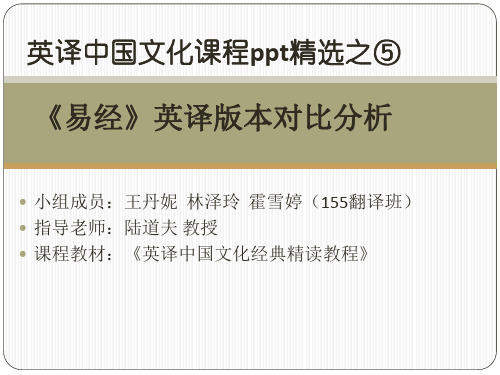
九三: 君子终日乾乾,夕惕若厉,无咎。
理雅各:
In the third line, undivided,(we see its
subject as) the superior man active and vigilant all the day,and in the evening still careful and apprehensive. (The position is) dangerous,but there will be no mistake. 每卦每爻的译句的主语都是由爻位充当的,所以开 头都是 “the first line”,然后“the second line”,依此类推。 爻位主语之后,经常是冗长的宾语从句表达爻辞内 容。翻译中带括号。
英译中国文化课程ppt精选之⑤
《易经》英译版本对比分析
小组成员:王丹妮 林泽玲 霍雪婷(155翻译班) 指导老师:陆道夫 教授 课程教材:《英译中国文化经典精读教程》
《易经》英译对比分析
小组成员 王丹妮 林泽玲 霍雪婷 翻译方向155班
目录
《易经》简介
《易经》译本介绍
《易经》题目英译对比 《易经》词语英译对比
邵乃读,曾于中国外交部和中国驻 外使馆工作多年。他用了二十余年 研究《易经》,写出《正本清源说 易经》一书。根据这一书,又出版 了中英双语本《易经新注》,此书 出版后在国内市场取得良好反响。
《易经》题目英译对比
《易经》题目英译
理雅各:The Book of Changes 贝恩斯:I Ching or Book of Changes
Ki”,表示箕子作为王公大臣的身份,并采用归化 和异化结合的方法,使译文既贴近原语言文化又易 于被不同文化背景的受众理解和接受。
易经英语的两种说法
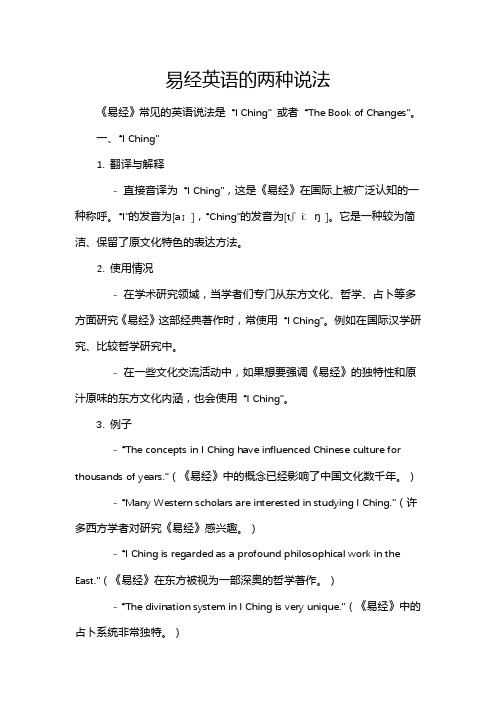
易经英语的两种说法《易经》常见的英语说法是“I Ching” 或者“The Book of Changes”。
一、“I Ching”1. 翻译与解释- 直接音译为“I Ching”,这是《易经》在国际上被广泛认知的一种称呼。
“I”的发音为[aɪ],“Ching”的发音为[tʃiːŋ]。
它是一种较为简洁、保留了原文化特色的表达方法。
2. 使用情况- 在学术研究领域,当学者们专门从东方文化、哲学、占卜等多方面研究《易经》这部经典著作时,常使用“I Ching”。
例如在国际汉学研究、比较哲学研究中。
- 在一些文化交流活动中,如果想要强调《易经》的独特性和原汁原味的东方文化内涵,也会使用“I Ching”。
3. 例子- “The concepts in I Ching have influenced Chinese culture for thousands of years.”(《易经》中的概念已经影响了中国文化数千年。
)- “Many Western scholars are interested in studying I Ching.”(许多西方学者对研究《易经》感兴趣。
)- “I Ching is regarded as a profound philosophical work in the East.”(《易经》在东方被视为一部深奥的哲学著作。
)- “The divination system in I Ching is very unique.”(《易经》中的占卜系统非常独特。
)- “Some artists get inspiration from I Ching.”(一些艺术家从《易经》中获取灵感。
)- “I Ching contains rich wisdom about life.”(《易经》包含丰富的人生智慧。
)- “The study of I Ching can help us understand ancient Chinese thinking.”(研究《易经》有助于我们理解古代中国人的思维。
周易英文课件
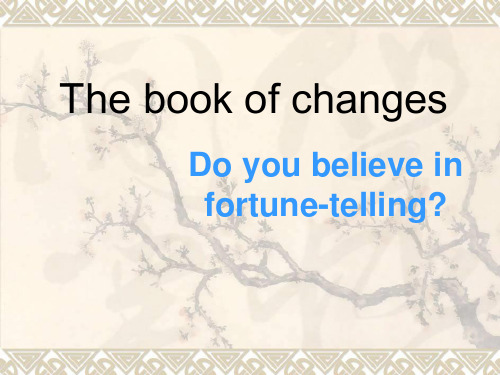
Yao (爻)
Each trigram consists of three lines.
The line is usually called Yao .
QIAN Trigram
KUN Trigram
Symbol
YANG
of
Yao
YIN
d a y
night
solid Hard moving
broken feminine still
Conclusion
The idea that any can be described in terms of two basic elements is beautiful in its simplicity and forms the foundation from which the Yi Jing was constructed.
Yao Embodiment
Yang yao:
Heaven Male Emperor Hard Strong Odd numbers 3579
Yin yao:
Earth Female Civilian Soft Weak Even numbers 2468
Example:269776
6 7 7 9 6 2
Exampole:269776
6 7 7 9 6 2
当一个事物发展到极致的时候, 他就要产生变化
How does the trigram take shape?
Eight Trigrams
• Eight trigrams called BaGua in Chinese language. • By putting together three lines, Yin and Yang, in all possible combination to represent the eight basic elements.
周易是中国最古老的经典著作之一英语翻译
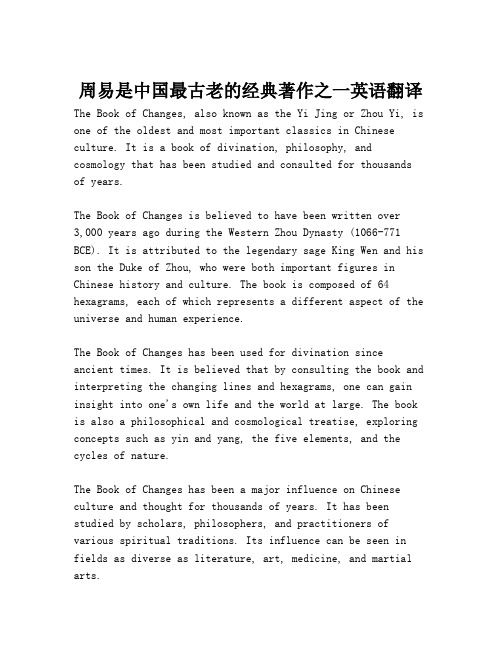
周易是中国最古老的经典著作之一英语翻译The Book of Changes, also known as the Yi Jing or Zhou Yi, is one of the oldest and most important classics in Chinese culture. It is a book of divination, philosophy, and cosmology that has been studied and consulted for thousands of years.The Book of Changes is believed to have been written over3,000 years ago during the Western Zhou Dynasty (1066-771 BCE). It is attributed to the legendary sage King Wen and his son the Duke of Zhou, who were both important figures in Chinese history and culture. The book is composed of 64 hexagrams, each of which represents a different aspect of the universe and human experience.The Book of Changes has been used for divination since ancient times. It is believed that by consulting the book and interpreting the changing lines and hexagrams, one can gain insight into one's own life and the world at large. The book is also a philosophical and cosmological treatise, exploring concepts such as yin and yang, the five elements, and the cycles of nature.The Book of Changes has been a major influence on Chinese culture and thought for thousands of years. It has been studied by scholars, philosophers, and practitioners of various spiritual traditions. Its influence can be seen in fields as diverse as literature, art, medicine, and martial arts.In recent years, the Book of Changes has become increasingly popular outside of China as well. Its insights into the nature of change and transformation have resonated with people all over the world, and it has been translated into many languages. Today, the Book of Changes remains one of the most enduring and important works of Chinese literature and philosophy.。
闵福德翻译易经
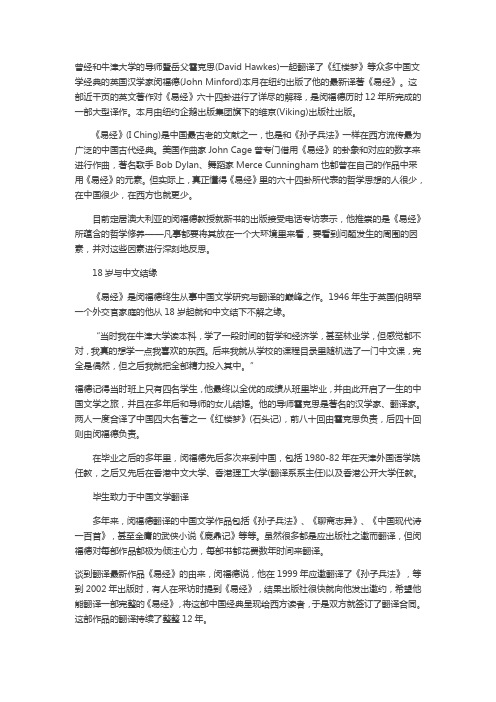
曾经和牛津大学的导师暨岳父霍克思(David Hawkes)一起翻译了《红楼梦》等众多中国文学经典的英国汉学家闵福德(John Minford)本月在纽约出版了他的最新译著《易经》。
这部近千页的英文著作对《易经》六十四卦进行了详尽的解释,是闵福德历时12年所完成的一部大型译作。
本月由纽约企鹅出版集团旗下的维京(Viking)出版社出版。
《易经》(I Ching)是中国最古老的文献之一,也是和《孙子兵法》一样在西方流传最为广泛的中国古代经典。
美国作曲家John Cage曾专门借用《易经》的卦象和对应的数字来进行作曲,著名歌手Bob Dylan、舞蹈家Merce Cunningham也都曾在自己的作品中采用《易经》的元素。
但实际上,真正懂得《易经》里的六十四卦所代表的哲学思想的人很少,在中国很少,在西方也就更少。
目前定居澳大利亚的闵福德教授就新书的出版接受电话专访表示,他推崇的是《易经》所蕴含的哲学修养——凡事都要将其放在一个大环境里来看,要看到问题发生的周围的因素,并对这些因素进行深刻地反思。
18岁与中文结缘《易经》是闵福德终生从事中国文学研究与翻译的巅峰之作。
1946年生于英国伯明罕一个外交官家庭的他从18岁起就和中文结下不解之缘。
“当时我在牛津大学读本科,学了一段时间的哲学和经济学,甚至林业学,但感觉都不对,我真的想学一点我喜欢的东西。
后来我就从学校的课程目录里随机选了一门中文课,完全是偶然,但之后我就把全部精力投入其中。
”福德记得当时班上只有四名学生,他最终以全优的成绩从班里毕业,并由此开启了一生的中国文学之旅,并且在多年后和导师的女儿结婚。
他的导师霍克思是著名的汉学家、翻译家。
两人一度合译了中国四大名著之一《红楼梦》(石头记),前八十回由霍克思负责,后四十回则由闵福德负责。
在毕业之后的多年里,闵福德先后多次来到中国,包括1980-82年在天津外国语学院任教,之后又先后在香港中文大学、香港理工大学(翻译系系主任)以及香港公开大学任教。
四书五经英文版
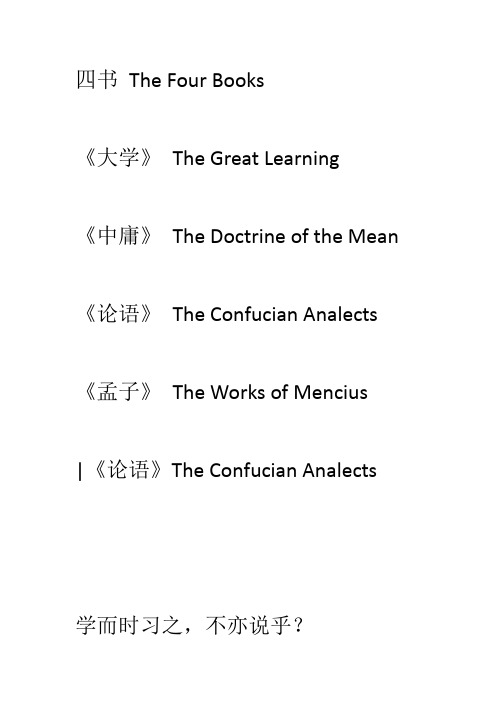
四书The Four Books《大学》The Great Learning《中庸》The Doctrine of the Mean 《论语》The Confucian Analects 《孟子》The Works of Mencius|《论语》The Confucian Analects 学而时习之,不亦说乎?It is indeed a pleasure to acquire knowledge and, as you go on acquiring, to put into practice what you have acquired.有朋自远方来,不亦乐乎?A greater pleasure still it is when friends of congenial minds come from afar to seek you because of your attainments.温故而知新,可以为师矣。
If a man will constantly go over what he has acquired and keep continually adding to it new acquirements, he may become a teacher of men.学而不思则罔,思而不学则殆。
Study without thinking is labor lost. Thinking without study is perilous.君子周而不比,小人比而不周。
A wise man is impartial, not neutral. A fool is neutral but not impartial.知之为知之,不知为不知,是知也。
To know what it is that you know, and to know what it is that you do not know, —that is understanding.辜鸿铭译|《孟子》The Works of Mencius故天将降大任于斯人也,必先苦其心志,劳其筋骨、饿其体肤,空乏其身,行拂乱其所为,所以动心忍性,曾益其所不能。
易经 英语简介

I-Ching and directions
西北
太阴
北 东北
少阴
西
东
少阳
西南
南
东南
太阳
Other perspectives: ① day ( hour change) ② month and season (season change) ③ body part
《易传· 说卦》: “乾为首 ( head ), 坤为腹 ( belly ), 震为足 ( foot ), 巽为股 ( thigh ), 坎为耳 ( ear ), 离为目 ( eye ), 艮为手 ( hand ), 兑为口 ( mouth )
韦编三绝 (Confucius broke The Book of Changes many times for he read it with such high frequency that the thread had to be replaced and renewed again and again. )
大肠 (large intestine)
辰时(7点-9点):胃(stomach) 巳时(9点-11点):脾(spleen)
午时(11点-13点) :心 (heart) 未时(13点-15点) : 小肠 (small intestine) 申时(15点-17点) : 膀胱 (urinary bladder) 酉时(17点-19点) :肾 (kidney) 戌时(19点-21点) :心包 亥时(21点-23点) :三焦
The Book of Changes (易经)
The origin of I-Ching
《易•系辞传》曰:“古者包牺氏(伏羲氏)
国学-易经(I-Ching中英文对照)
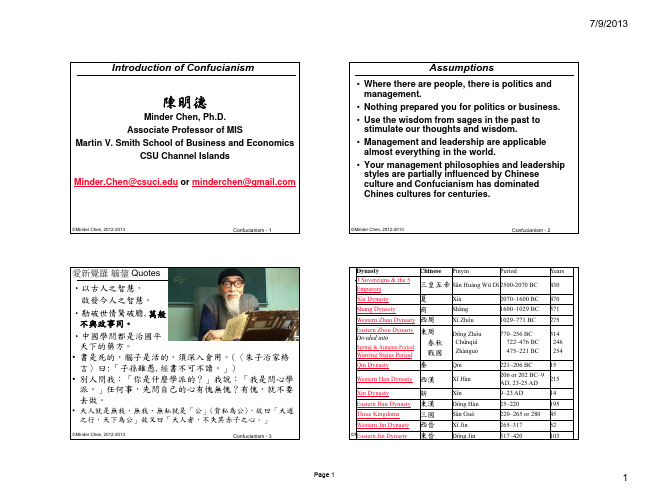
Confucianism - 3
Confucianism - 4103 317–420
Page 1
1
7/9/2013
Dynasty Chinese Southern and Northern 南北朝 Dynasties Sui Dynasty Tang Dynasty Five Dynasties and Ten Kingdoms Northern Song Dynasty Southern Song Dynasty Liao Dynasty Jin Dynasty Western Xia Yuan Dynasty Ming Dynasty Qing Dynasty
ఙقᆈ
Minder Chen, Ph.D. Associate Professor of MIS Martin V. Smith School of Business and Economics CSU Channel Islands Minder.Chen@ or minderchen@
隋 唐
五代十國 Wǔ Dài Shí Guó 907–960 北宋 南宋 遼 金 西夏 元 明 清
Běi Sòng Nán Sòng Liáo Jīn Xī Xià Yuán Míng Qīng 960–1127 1127–1279 907 or 916–1125 1115–1234 1038–1227 1271–1368 1368–1644 or 1662
夏 Shang Dynasty 商 Western Zhou Dynasty 西周 東周 春秋 Spring & Autumn Period 戰國 Warring States Period Qin Dynasty 秦
Western Han Dynasty Xin Dynasty Eastern Han Dynasty Three Kingdoms Western Jin Dynasty
中国元素英文翻译
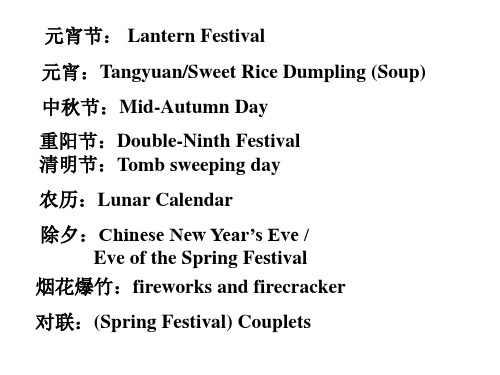
火药:gunpowder 剪纸:Paper Cutting 春卷:Spring Roll(s) 书法:Calligraphy 刺绣:embroidery 旗袍:cheongsam
莲藕:Lotus Romic Dialogue 针灸:Acupuncture
《水浒》:Water Margins/Outlaws of the Marsh 《西游记》:The Journey to the West 《三国演义》:The Romance of Three Kingdoms 《红楼梦》:The Dream of Red Mansion 四合院:Siheyuan/Quadrangle 太极拳:Tai Chi 黄土高原:Loess Plateau 京剧:Beijing Opera/Peking Opera 秦腔:Crying of Qin People/Qin Opera
元宵节: Lantern Festival 元宵:Tangyuan/Sweet Rice Dumpling (Soup) 中秋节:Mid-Autumn Day 重阳节:Double-Ninth Festival 清明节:Tomb sweeping day 农历:Lunar Calendar 除夕:Chinese New Year’s Eve / Eve of the Spring Festival 烟花爆竹:fireworks and firecracker 对联:(Spring Festival) Couplets
五经:The Five Classics 《诗经》:The Book of Songs 《尚书》:The Book of History 《易经》:The Book of Changes 《礼经》:The Book of Rites 《春秋》:The Spring and Autumn Annals 《史记》:Historical Records/Records of the Grand Historian 《唐诗三百首》:300 Tang Poems 《宋词三百首》:300 Song Lyrics 古装片:Costume Drama
- 1、下载文档前请自行甄别文档内容的完整性,平台不提供额外的编辑、内容补充、找答案等附加服务。
- 2、"仅部分预览"的文档,不可在线预览部分如存在完整性等问题,可反馈申请退款(可完整预览的文档不适用该条件!)。
- 3、如文档侵犯您的权益,请联系客服反馈,我们会尽快为您处理(人工客服工作时间:9:00-18:30)。
Yao
+
author
Shi Yi/Yi
Zhuan [易传]----during the time of Spring and Autumn Period, Confucius is traditionally said to have written the Shi Yi, a group of commentaries of the I Ching.
+trigrams
+
trigrams
Yang
[九]----the solid line represents Yang, the creative principle. principle.
open line represents Yin, the receptive
Yin[六]----the Yin Yang
+
comments
I
Ching was lucky to survive after the Qin Empire’s Burning of books and burying of scholars because of the divination factors. Chinese civilization, as with early Western civilization, accepted various pre-scientific explanations of natural events, and the I Ching has been cited as an example of this. Thus it interpreted natural events through reading based on symbols expressed in the trigrams and hexagrams.
+
hexagram
the
lower trigram--The first 3 lines of the hexagram, called the lower trigram, are seen as the inner aspect of the change that is occurring. The upper trigram is the outer aspect.
+
That
Amelia Zhang
2014/4/17
the dynamic of the inner (personal) aspect relating to the outer (external) situation.
Change----
+
hexagram
64
hexagrams---- I Ching describes each of the 64 hexagrams, and later scholars added commentaries and analyses of each one.
+
Cosmology[宇宙论]/philosophy--During
the Warring States Period[], the text was reinterpreted as a system of cosmology and philosophy that subsequently became intrinsic to Chinese culture.
centered on the ideas of the dynamic balance of opposites, the evolution of events as a process, and acceptance of the inevitability of change.
Balance--It
Prior
to the Tokugawa period[德川幕府家族]in Japan, the I Ching was little known and used mostly for divination until Buddhist monks popularized the Chinese classic for its philosophical, cultural and political merits in other literate groups such as the samurai[武士阶级].
64
+
Gua
Ci[卦辞]----at the time of Shang’s last king, Zhou Wang, King Wen of Zhou is said to have deduced the hexagram and discovered that the hexagram beginning with Initiating[乾]revealed the rise of Zhou. He then gave each hexagram a description regarding its own nature.
Ci [爻辞]---- King Wu of Zhou, his brother is said to have created Yao Ci, to clarify the significance of each horizontal line in each hexagram.
Still not enough!
theory----these principles are more commonly known in the west as the Yin-Yang diagram, expressing the idea of complementarity of change:when Yang is at stop, Yin is increasing, and vice versa.
+
I Ching
Amelia Zhang
+
Basic meaning Trigrams Different country hexagra m
comments
introduction structure influence
+
introduction
+
The
I Ching, also known as the Classic of Changes, Book of Changs, Zhouyi and Yijing, is one of the oldest of the Chinese classic texts. book contains a divination system comparable to Western geomancy[风水] system; in Western cultures and modern East Asia, it is still widely used foe this purpose.
+
comments
I
Ching [易]means “easy” or “simple”, whilst as a verb it indicates “change” or the exchange or substitution. Yin and yang, whilst common expressions associated with many schools of classical Chinese culture, are especially associated with the Taoists. In imperial China the I Ching had two distinct fictions. The first was as a compendium and classic ancient cosmic principles. The second function was that of divination text.
+
Which one are you familiar + with?
+ examples
+
The creative--force
Possessing Creative Power &skill
+ Qian—heaven
乾:元,亨,利,贞。
初九:潜龙勿用。 九二:见龙在田,利见大人。 九三:君子终日乾乾,夕惕若,厉无咎。 九四:或跃在渊,无咎。 九五:飞龙在天,利见大人。 上九:亢龙有悔。
初六:履霜坚冰至。
六二:直方大,不习,无不利。
六三:含章可贞,或从王事,无成有终。
六四:括囊,无咎无誉。 六五:黄裳,元吉。 上六:龙战于野,其血玄黄。 用六:利永贞。
+
Comments
1· 居下处始时,要善于做小事,防患于未然 2· 居下处事时,内方外园,张弛有度。 3· 居下有为时,善世而不伐,功成而不有。 4· 居下近尊时,韬光藏锐,清虚自守。 5· 以下临尊时,仁善中正,宽厚容民。 6· 居下大成时,阴阳合和,返璞归真。 7· 永远恪守的原则:坚守正道,持信永固
The
+
Do you think who was the author?
??
+ author
Maybe …….
Fu X i
+
8
trigrams[八卦]----Traditionally it was believed that the principles of the I Ching originated with the mythical Fu Xi. In this respect he is seen as an early culture hero, one of the earliest legendary rulers of China.
